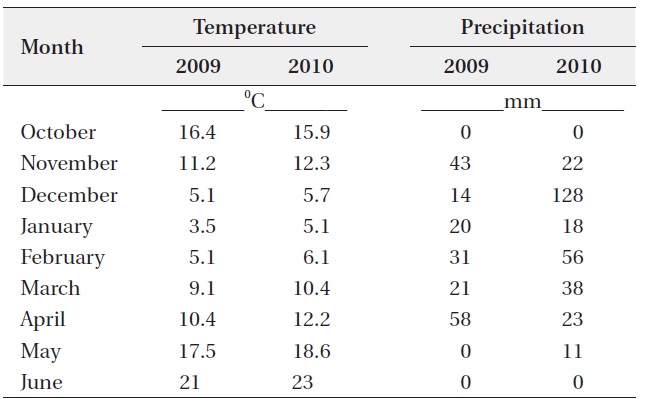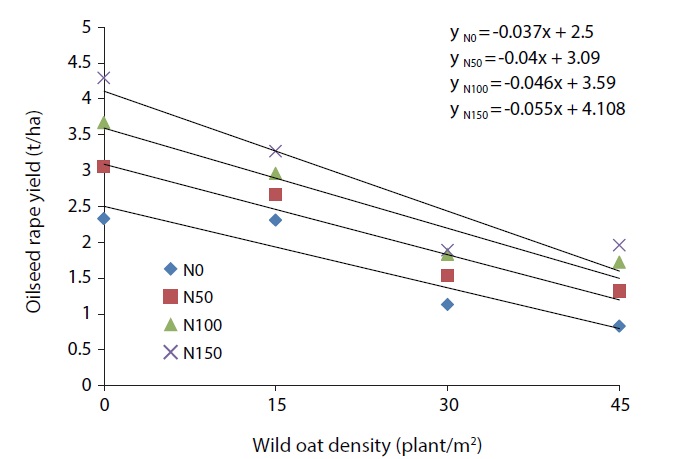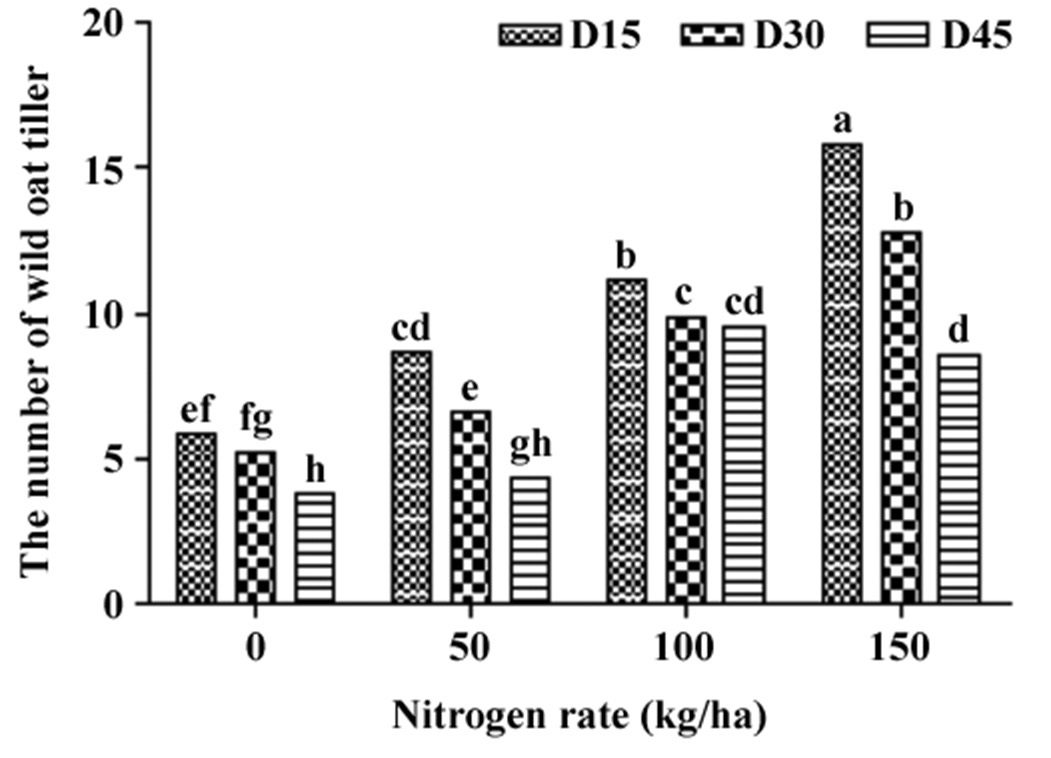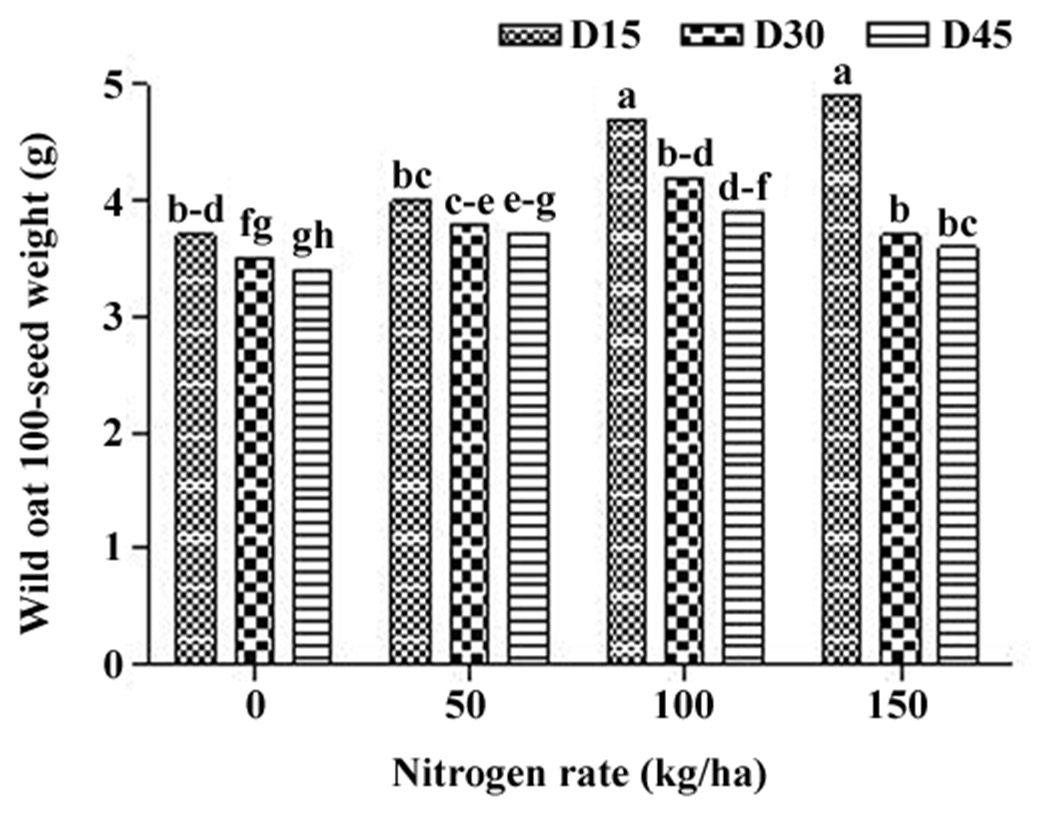



A Two-year field experiment was carried out in 2009 and 2010 to evaluate the effects of different densities of wild oat and nitrogen (N) rates on oilseed rape yield and yield components. Experimental design was split plot with three replications. Increased nitrogen rates up to 150 kg N/ha caused an increase in oilseed rape grain yield in weed-free plots (4.26 t/ha; 1t = 103 kg), while even at the lowest density of wild oat (15 plants/m2), increasing N fertilizer only up to 50 kg/ha led to a significant increase in grain yield. Wild oat growth was favored by high levels of N. Intraspecific competition reduced biomass, 100-seed weight and number of tillers of wild oat. Both lower N rate and intraspecific competition had negative effect on wild oat growth but the weed was still able to produce a considerable number of tillers and vigorous seeds. It showed that wild oat possess a notable adaptive plasticity and can allocate a greater proportion of its resource toward reproductive organs even under resource shortage conditions and, thus, it may increase the competitive ability of the weed over the crop.Our results suggest that effective weed management should be done to prevent wild oat seed production in crops preceding oilseed rape as well as to control the weed at early season in oilseed rape fields.
Oilseed rape (
Nitrogen (N) is the major element nutrient to increase crop yield in the production of non-legume crops and thus its management is essential due to high environmental risk and cost (Bosnic and Swanton 1997). It have been reported that many weeds are high N consumers (Hans and Johnson 2002, Blackshaw 2005), which can limit N resources for crop growth (Blackshaw 2005). They not only decrease soil N availability for crops but their growth and competitiveness also are increased by higher N rates (Blackshaw et al. 2003, 2004). It has been shown that weed-crop competitive interaction could be changed by N levels (Carlson and Hill 1985, Ampong-Nyarko and de Datta 1993, Santos et al. 1998, Dhima and Eleftherohorinos 2001, Andreasenet al. 2006, Naderi and Ghadiri 2011). In contrast, other researchers showed that N had little impact on weed-crop competition (Satorre and Snaydon 1992, Gonzalez Ponce 1998). Interestingly, some studies indicated that results might be crop and/or weed species specific. For example, Blackshaw and Brandt (2008) reported that competitiveness of Persian darnel (
Growing competitive crops is one of the most important weed management strategies which can reduce environmental damage associated with agricultural production such as herbicides. Although some researchers have evaluated the competitiveness of wheat and barley with wild oat (Morishita et al. 1991, Ghadiri et al. 2008), there is limited information on wild oat and oilseed rape competitive interaction. Therefore, this research was carried out to evaluate the effects of different densities of wild oat and N rates on oilseed rape yield in order to determine the optimal rate of N application under competition conditions.
A Two-year field experiment was carried out in 2009 and 2010 at the Research Field of Agricultural College of Shiraz University, Iran. Plots were located on a silty loam soil with 0.75% organic matter, 0.05% total N, 21.8 mg/kg phosphorus, 600 mg/kg potassium, pH of 7.56, and electrical conductivity (EC) of 0.52 dS/m in the surface horizon (0-20 cm). Commercial oilseed rape seeds, cultivar Talayeh, were sown on October 1, 2009 and 2010 in 3 × 6 m plots. Each plot consisted of 4 rows spaced 75 cm apart expecting a plant density of 80 plants/m2. Experimental design was split plot with three replications. Main plots consisted of four N levels (0, 50, 100 and 150 kg N/ha), and sub plots consisted of four wild oat densities (0, 15, 30 and 45 plants/m2),resulting in a total of 48 plots. Appropriately weighed amount of wild oat seeds were hand broadcast to attain the desired density. Irrigation intervals were 8 days according to the concurrent local practice. All plots were kept free from pests, diseases and the other weeds during the experimental period. Meteorological data are given in Table 1.
At crop maturity, the two middle rows from each plot were sampled for determination of yield and yield components. Additionally, weeds were harvested from a 2 m2 area per plot and dried at 75℃ for 48 h. Wild oat tillers and 100-seed weight was also measured. Analysis of variance over years indicated that year by nitrogen rates by wild oat density interaction was not significant (
Oilseed rape grain yield was varied according to wild oat density and N rate (Fig. 1). Models were fitted to oilseed rape grain yield data, and estimated parameters are given in Table 2. Grain yield at weed-free plots receiving

Mean monthly temperature and precipitation received during the growing seasons of 2009 and 2010
100 and 150 kg N/ha ranged from 3.67 to 4.29 t/ha in our study which were common yield gained in this region. Wild oat competition led to a large reduction (15-55%) in oilseed rape grain yield, so that the yield was decreased as wild oat density increased (Fig. 1).
Nitrogen and wild oat density had a significant effect on oilseed rape yield (Table 3). Increased nitrogen rates caused an increase in oilseed rape grain yield but no significant differences were found between 100 and 150 kg N/ha. Although in weed-free plots increasing N fertilizer

Estimated parameter values of linear models for oilseed rape yield as a function of wild oat density at the various nitrogen rates

Analysis of variance results for oilseed rape grain yield, wild oat biomass, wild oat tillers, and wild oat 100-seed weight
up to 150 kg N/ha caused a significant increase in oilseed rape grain yield, even at the lowest wild oat density (15 plants/m2), increasing N fertilizer up to 50 kg/ha led to a significant increase in grain yield (
Interaction of N rate and wild oat density was significant for wild oat biomass (Table 3 and Fig. 2) (
>
Wild oat tillers and 100-seed weight
Nitrogen application consistently increased wild oat tillers and 100-seed weight (

Estimated parameter values of quadratic models for wild oat biomass as a function of wild oat density at the various nitrogen rates
and 100-seed weight were attained at 15 plants/m2. Wild oat tillers and 100-seed weight was affected by the interaction of N rate and wild oat density (
Oilseed rape grain yield data showed that applying high levels of N can increase the weed competitiveness. Under weed-free conditions, a higher rate of N fertilizer increased oilseed rape yield. However, in the presence of wild oat, oilseed rape yield was reduced at each N rate. Similarly, it has been found that fertilizer usually stimulates weed growth to the crop’s detriment in most cases. Crop yield in weedy, fertilized plots are usually equal to those in weeded, un-fertilized plots (Zimdahl 2004). It has been shown that increased nitrogen could enhance the competitiveness of weeds more than crops, and crop yield remained either unchanged or decreased in some cases (Carlson and Hill 1985, Ampong-Nyarko and de Datta 1993, Santos et al. 1998, Dhima and Eleftherohorinos 2001, Andreasen et al. 2006). Studying competition between wild mustard (
Significant interaction between wild oat density and the N rate for oilseed rape yield showed that N was an important factor in the weed crop competition. Generally, weeds have a large nutrient demand and they will absorb as much or more than crops (Zimdhal 2007). Similarly, Daugovish et al. (2002) found that canola was a poor competitor with wild oat and it was not able to suppress wild oat reproduction effectively. We found that, wild oat was better able to exploit the added nitrogen and thus could obtain a superior competitiveness over the oilseed rape. A negative wheat yield response to nitrogen at high wild oat density has also been found (Carlson and Hill 1985, Ghadiri et al. 2008).However, this is in contrast to the results obtained by Blackshaw and Brandt (2008) who reported that wild oat competitiveness was uninfluenced by N fertilizer rate. Since wild oat seedlings are initially taller than oilseed rape, they can suppress the crop’s production by competing effectively at the early stage of oilseed rape development (Chow and Dorrell 1979). Additionally, the lag phase in oilseed rape elongation is likely responsible for its lower competitiveness versus wild oat. This could also be associated with tillering ability of wild oat as well as its superior elevation above the canopy of oilseed rape that may make them better competitors over the crop for light (Daugovish et al. 2002, Vasilakoglou and Dhima 2012).
Wild oat dry weight in the high density was higher under high N conditions than under low N conditions, showing that high level of N application was not able to increase competitive ability of oilseed rape in the present study. In our study, the best description of the relationship between wild oat density and biomass was provided by quadratic model. It have been also reported that the quadratic model is the best fit for the relationship between density and wild mustard (Naderi and Ghadiri 2011) and wild radish (
Weed dry weight data also indicated that there was a high intraspecific weed competition at higher weed density. Although both lower N rate and intraspecific competition had negative effect on wild oat growth, the weed was still able to produce a considerable number of tillers and vigorous seeds. This is indicating that wild oat possesses a notable adaptive plasticity and can allocate a greater proportion of its resource toward reproductive organs even under resource shortage conditions and, thus, it may increase the competitive ability of the weed over the crop.
Our results showed that wild oat could cause major yield losses in oilseed rape. Additionally, increased nitrogen rates caused an increase in oilseed rape grain yield but no significant difference between 100 and 150 kg N/ha was found. Since weed competition with crops can be affected by N rate application, soil fertility manipulation should be noted as an important component of integrated weed management. These findings confirm that wild oat is highly responsive to higher N rates and thus could be stronger competitors at higher N fertilizer rates. Furthermore, it can produce a considerable biomass and seed at various densities and N rates. Thus, effective weed management should be done to reduce wild oat populations and to prevent its seed production in crops preceding oilseed rape as well as to control the weed at early season in the crop fields. Future works should investigate whether different methods of fertilization, e.g., placement and/or timing, could affect oilseed rape grain yield and/ or wild oat growth and as a result weed-crop interaction.







